
Count the number of squares in the given figure.
13
16
19
20
Correct answer is B
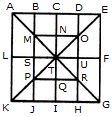
The figure may be labelled as shown.
The simplest squares are BCNM, CDON, PQIJ and QRHI i.e. 4 in number.
The squares composed of two components each are MNTS, NOUT, STQP and TURQ i.e. 4 in number.
The squares composed of five components each are ACTL, CEFT, TFGI and LTIK i.e. 4 in number.
The squares composed of six components each are BDUS and SUHJ i.e. 2 in number.
There is only one square i.e. MORP composed of eight components.
There is only one square i.e. AEGK composed of twenty components.
Total number of squares in the figure = 4 + 4 + 4 + 2+1 + 1 = 16.
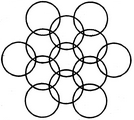
How many circles are there in the adjoining figure.
11
12
13
14
Correct answer is C
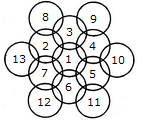
The figure may be labelled as shown.
There are 13 circles in the given figure. This is clear from the adjoining figure in which the centres of all the circles in the given figure have been numbered from 1 to 13.

Count the number of squares in the given figure.
6
7
9
10
Correct answer is C
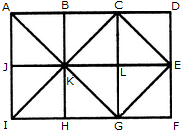
The figure may be labelled as shown.
The squares composed of two components each are ABKJ, BCLK, CDEL, LEFG, KLGH and JKHI i.e.6 in number.
There is only one square i.e. CEGK composed of four components.
The squares composed of eight components each are ACGI and BDFH i.e. 2 in number.
There are 6 + 1 + 2 = 9 squares in the figure.

Count the number of rectangles in the given figure.
8
17
18
20
Correct answer is C
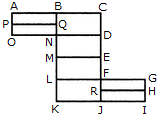
The figure may be labelled as shown.
The simplest rectangles are ABQP, PQNO, BCDN, NDEM, MEFL, LFJK, FGHR and RHIJ i.e. 8 in number.
The rectangles composed of two components each are ABNO, BCEM, NDFL, MEJK and FGIJ i.e. 5 in number.
The rectangles composed of three components each are ACDO, BCFL, NDJK and LGIK i.e. 4 in number.
There is only one rectangle i.e. BCJK composed of four components.
Total number of rectangles in the figure = 8 + 5 + 4 + 1 = 18.

Count the number of triangles and squares in the given figure.
44 triangles, 10 squares
14 triangles, 16 squares
27 triangles, 6 squares
36 triangles, 9 squares
Correct answer is A
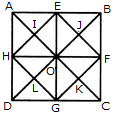
The figure may be labelled as shown.
Triangles :
The simplest triangles are AEI, EOI, OHI, HAI, EBJ, BFJ, FOJ, OEJ, HOL, OGL, GDL, DHL, OFK, FCK, CGK and GOK i.e. 16 in number.
The triangles composed of two components each are HAE, AEO, EOH, OHA, OEB, EBF, BFO, FOE, DHO, HOG, OGD, GDH, GOF, OFC, FCG and CGO i.e. 16 in number.
The triangles composed of four components each are HEF, EFG, FGH, GHE, ABO, BGO, CDO and DAO i.e. 8 in number.
The triangles composed of eight components each are DAB, ABC, BCD and CDA i.e. 4 in number.
Total number of triangles in the figure = 16 + 16 + 8 + 4 = 44.
Squares :
The squares composed of two components are HIOL, IEJO, JFKO and KGLO i.e. 4 in number.
The squares composed of four components are AEOH, EBFO, OFGC and HOGD i.e.4 in number.
There is only one square EFGH which is composed of eight components.
There is only one square ABCD which is composed of sixteen components.
Total number of squares in the figure = 4 + 4 + 1 + 1 = 10.
Aptitude Tests